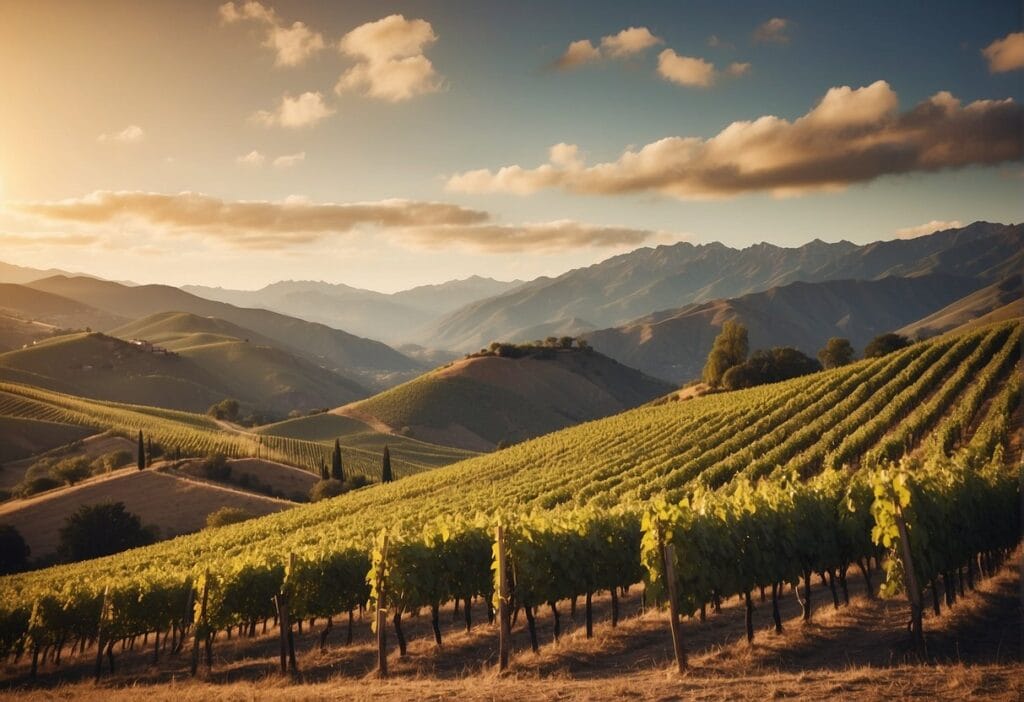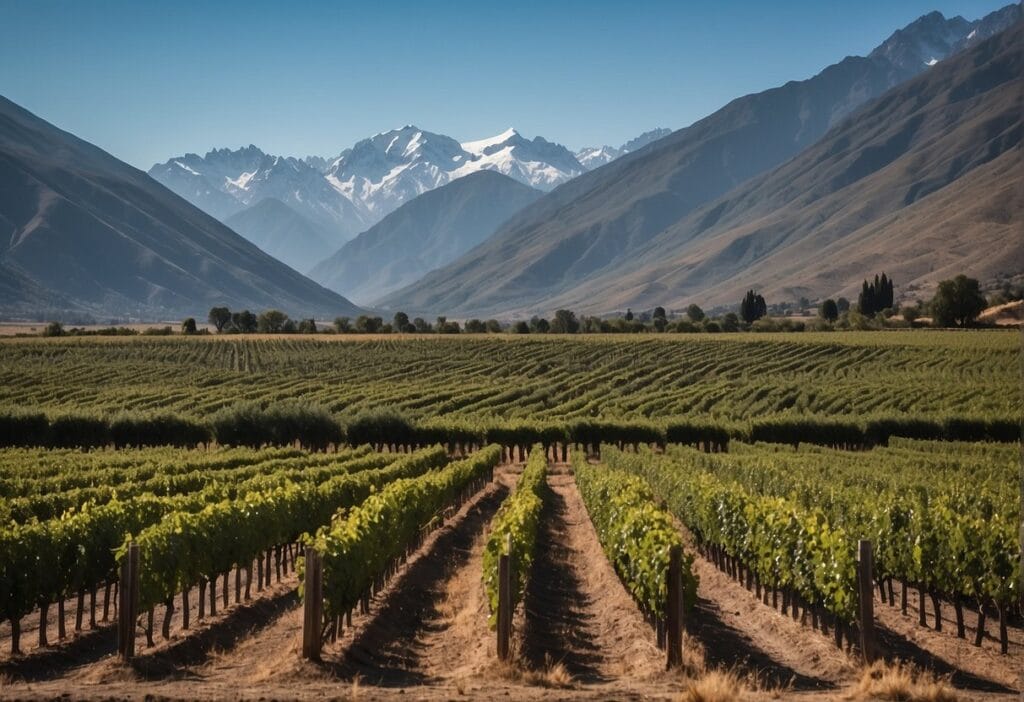Nestled in the heart of Italy, Tuscany is a region celebrated for its panoramic landscapes, rich history, and cultural heritage. Amongst these treasures, the Tuscan Wine Region emerges as a beacon of viticultural excellence, drawing enthusiasts from around the globe.
As you journey through rolling hills and rustic villas, you’ll find yourself immersed in the tradition of winemaking that dates back to the time of the Etruscans.
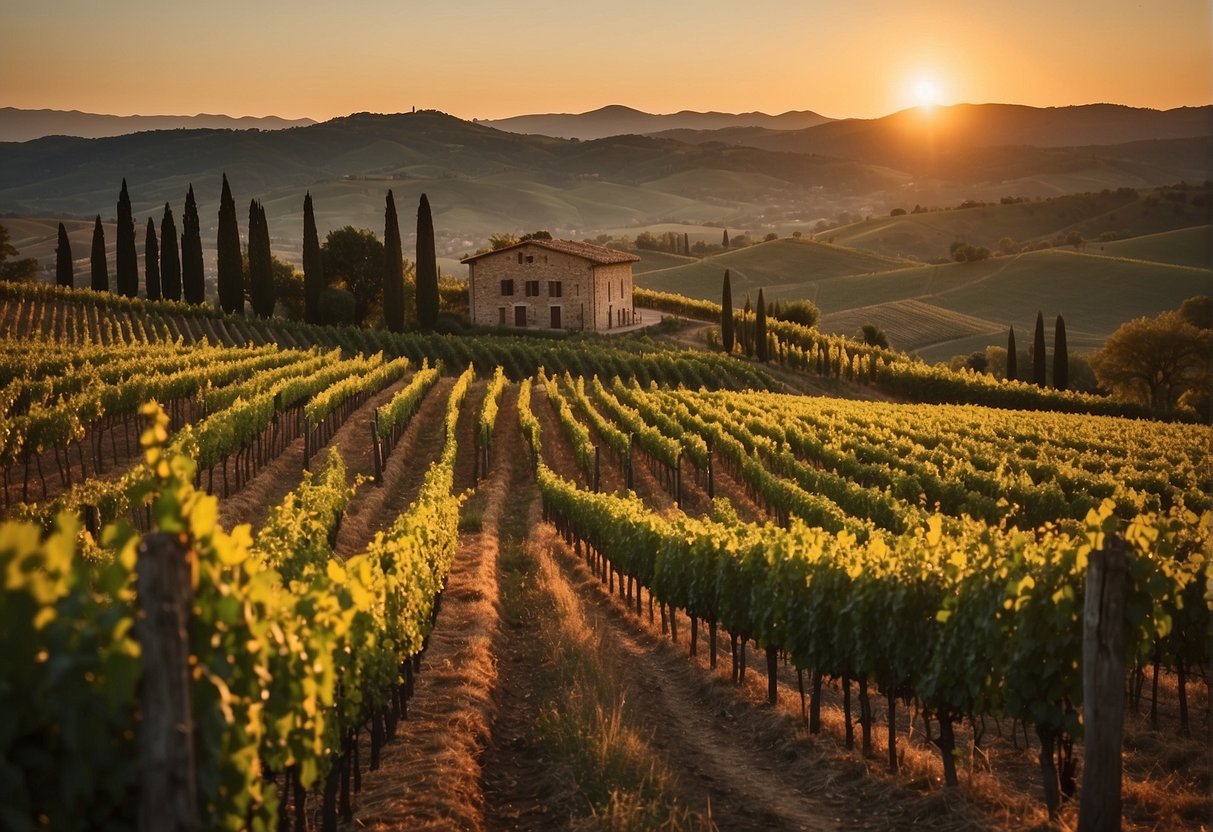
With a climate ideally suited for grape cultivation, Tuscany has become synonymous with exceptional wines renowned for their depth, variety, and quality.
Each bottle of Tuscan wine speaks to the diversity of the terrain—from the breezy coastlines to the sun-drenched valleys.
The key grape varieties, such as the noble Sangiovese, serve as the backbone for iconic Tuscan wines, including Chianti and Brunello di Montalcino, which embody the region’s winemaking prowess.
Exploring the Tuscan Wine Region isn’t just about tasting the wines; it’s a holistic experience that involves understanding the intricacies of viticulture and the winemaking process.
Whether you’re touring the historic wine territories or seeking to add coveted labels to your collection, Tuscany offers a welcoming embrace to novices and connoisseurs alike.
Key Takeaways
- Tuscany’s winemaking history enhances its global reputation for superb wines.
- The region’s grape varieties and terrains contribute to the unique profiles of Tuscan wines.
- Immersive experiences in Tuscany go beyond tasting, encompassing the full winemaking tradition.
Tuscany Wine Region Overview
Tuscany, located in central Italy, is not only a historical center but also one of the most renowned wine regions globally, known for its high-quality wines and strong wine-making heritage.
Geography and Climate
Tuscany’s diverse geography includes the Tyrrhenian Sea’s coastal areas and the inland Apennine Mountains, which contribute to the region’s varied microclimates.
These microclimates are essential for the growth of grape vines, with coastal areas offering a warmer, maritime climate and inland regions characterized by cooler temperatures.
The varied climate ensures a longer growing season, which is ideal for the wine appellations spread across this celebrated region.
History and Culture
Influenced by the Etruscans and the Roman Empire, Tuscany has a rich winemaking history that dates back to the 8th century BC.
Mezzadria, a sharecropping system that was prominent until the 20th century, played a significant role in shaping Tuscany’s winemaking tradition.
This culture of winemaking has been passed down through generations, and today, Tuscany remains steeped in this inherited knowledge and age-old practices.
Wine Appellations and Classification
Tuscany’s wine region is divided into several appellations that follow strict classification systems to ensure quality:
- DOC (Denominazione di Origine Controllata): This level signifies high-quality wines with regulations controlling geographic region, grape varieties, and winemaking methods.
- DOCG (Denominazione di Origine Controllata e Garantita): A step above DOC, these wines undergo stringent testing to meet particularly high standards.
- IGT (Indicazione Geografica Tipica): A classification for wines that often encompass innovative blends and styles not adhering to traditional DOC/DOCG rules.
- Vino da Tavola: The basic classification for table wines, this category isn’t bound by strict geographic restrictions.
Tuscany’s appellations include prestigious areas such as Chianti, Montalcino, and Montepulciano, each producing distinct wines reflective of their unique terroir.
Key Grape Varieties
When you explore the wines of Tuscany, you’ll find that this region has a rich palette of grape varieties. Each offers a unique profile to the world-renowned Italian wines produced here.
Red Grape Varieties
Sangiovese: As Tuscany’s star, the Sangiovese grape is the backbone of iconic wines such as Chianti and Brunello di Montalcino. It’s renowned for its earthy flavors and robust tannins, which provide excellent aging potential.
Merlot & Cabernet Sauvignon: These international varieties have found a welcoming home in Tuscany. You might be familiar with the term Super Tuscan; these wines often have a blend that includes Merlot and Cabernet Sauvignon, adding richness and depth.
Canaiolo and Ciliegiolo: These indigenous grapes are typically supporting players that add complexity and a touch of softer fruit flavors.
Colorino: Known for its deep color and used to add a richer hue to blends, Colorino is another grape that contributes to the complexity of Tuscan reds.
White Grape Varieties
Trebbiano: This is the most widely planted white grape in Italy, giving you fresh and crisply neutral wines.
Malvasia: Often blended with Trebbiano, Malvasia adds aromatic sweetness to the wine, creating a pleasantly balanced flavor.
Vernaccia: Unique to the area around San Gimignano, the Vernaccia grape makes a distinctively crisp and minerally white wine with a hint of the trademark Tuscan herbaceousness.
Vermentino: More coastal, Vermentino thrives near the Mediterranean and brings forth bright acidity with refreshing citrus and floral notes.
Iconic Tuscan Wines
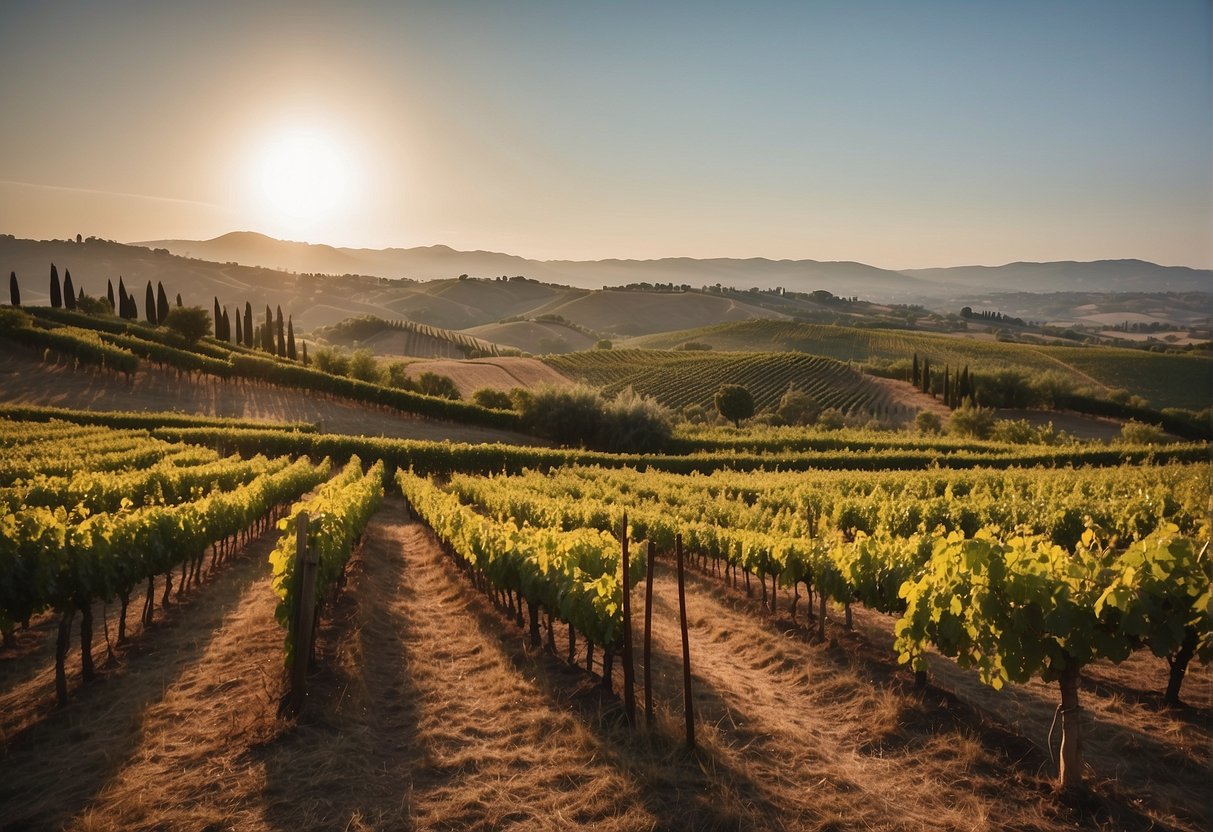
Tuscany is renowned for its quality and variety, home to some of the most prestigious wines in the world. As you explore this rich wine landscape, you’ll encounter a tapestry of flavors that truly encapsulate the essence of Italian winemaking.
Chianti and Chianti Classico
Chianti, recognized by its iconic Black Rooster seal, is a red wine that reflects the heart of the Tuscan wine tradition.
Chianti Classico, a more specific and often higher quality subset of Chianti, is made from Sangiovese grapes and offers a robust, complex flavor. Look for Chianti Classico Riserva for wines aged longer, presenting an even greater depth of taste.
Brunello di Montalcino and Vino Nobile
Montalcino is home to the exquisite Brunello di Montalcino, a wine praised for its full-bodied richness and aging potential.
Nearby, Montepulciano gives birth to Vino Nobile di Montepuliano, another stellar red that balances elegance and robust tannins, showcasing the versatility of Sangiovese grapes in Tuscany.
Super Tuscans and Other Reds
Emerging from the coastal Bolgheri zone, Super Tuscans like Sassicaia and Ornellaia break traditional molds, often blending Sangiovese with varieties like Cabernet Sauvignon.
Other notable reds like Morellino di Scansano and Carmignano have also staked their claim in the Tuscan wine repertoire, offering distinctive tastes outside the usual Sangiovese palette.
White and Dessert Wines
Tuscany’s white wines, though less famous, are equally compelling. Vernaccia di San Gimignano stands out with its crisp, floral notes.
For a sweet finish, the region’s Vin Santo and Passito Dessert Wines offer rich, honeyed flavors that perfectly complement the Tuscan wine experience.
Tuscan Wine Territories
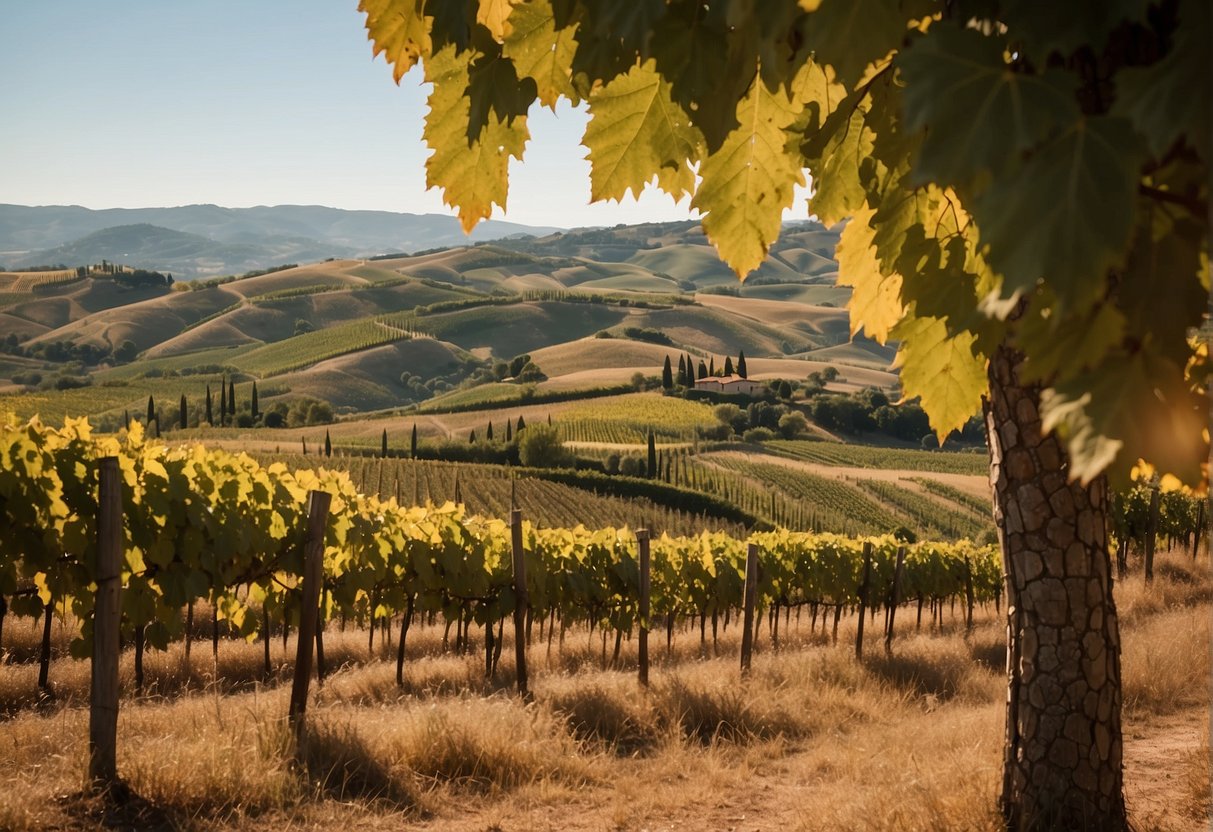
Tuscany, a jewel of Italy, offers you a rich tapestry of wine territories, each with its distinct character shaped by the unique terroir, from the coastal stretches bathed by the Tyrrhenian Sea to the iconic hilltop towns filled with centuries of winemaking heritage.
Maremma and the Tuscan Coast
The Maremma area, with its picturesque landscapes and proximity to the Tuscan Coast, provides a dynamic setting for viticulture. Here, the maritime influence of the Tyrrhenian Sea melds with the rich clay and sand soils to create wines with a singular expression. You’ll discover an array of varietals that capture the coastal essence in every bottle.
Central Tuscany’s Hilltop Towns
Venturing inland, the central Tuscan hilltop towns like Florence, Siena, and notably San Gimignano enhance the region’s winemaking mosaic.
San Gimignano, known for its Vernaccia di San Gimignano, offers a rare white wine experience amidst a region celebrated for its reds.
The Val d’Orcia and Montalcino areas further solidify Central Tuscany’s reputation, where prestigious wines such as Brunello di Montalcino originate.
The Chianti Region
Your journey isn’t complete without exploring the Chianti Region, the heartland of Tuscan winemaking.
Towns such as Greve, Castellina, and Radda in Chianti form the vertexes of the Chianti Classico area. The rolling hills and diverse terroir, from alberese limestone to galestro schist, contribute to the signature Chianti wines loved around the world.
Unique Tuscan Terroirs
Tuscany’s varied landscapes foster unique terroirs. The Chianti Rufina area, although less known, produces elegant and long-lived wines. Meanwhile, the Colli Fiorentini region near Florence is recognized for its approachable yet distinct Chianti wines.
You’ll unravel the subtle nuances of each terroir, reflecting the dynamic interplay of soil, climate, and tradition that makes Tuscany’s wines truly extraordinary.
Viticulture and Winemaking
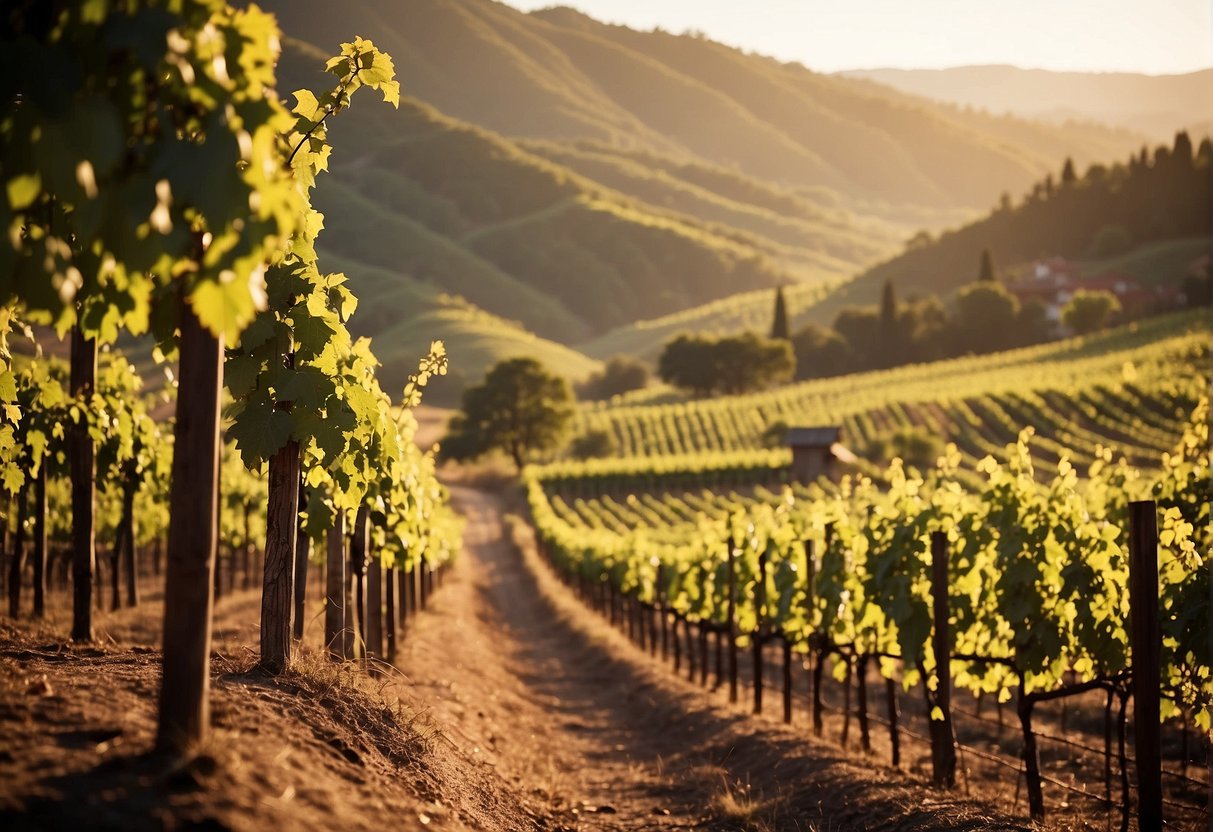
In the heart of Italy, your journey into the Tuscany wine region reveals a blend of time-honored and contemporary techniques. Here, the ancient art of growing grapes meets the science of winemaking, creating a tapestry woven with tradition and innovation.
Traditional Methods
Viticulture in Tuscany takes advantage of the diverse terroir—a unique combination of climate, soil, and topography. This results in wines that reflect the very essence of the region.
The structure of these wines owes much to traditional practices, such as those pioneered by Barone Ricasoli, who was instrumental in developing the formula for Chianti, one of Tuscany’s most famous wines.
Locals maintain a deep respect for history, which is evident in every bottle. For generations, Marchesi Antinori has cultivated vineyards, influencing both the landscape and winemaking approaches that honor tradition and place.
- Selective Harvesting: Hand-picking grapes ensures only the best quality.
- Aging: Using oak barrels for a period that can extend to years.
Modern Innovations
While respecting tradition, Tuscan winemakers also embrace modern innovations.
Advancements in vinification techniques enable winemakers to enhance their wine’s complexity and longevity.
The integration of temperature-controlled fermentation and modern machinery has allowed for a more consistent and refined product.
- Precision Viticulture: Harnessing technology to monitor and manage vineyards.
- Sustainable Practices: Using organic and biodynamic methods to protect the land.
Exploring Tuscany’s Wine Scene

Tuscany’s wine scene is a tapestry of historic vineyards and vibrant wine events. Dive in to experience the synergy between the region’s rich culinary traditions and legendary viticulture.
Wine Tours and Tastings
When in Tuscany, wine tours and tastings are essential to understanding the area’s winemaking heritage.
Book a tour to explore the rolling vineyards and indulge in tastings where the expertise of local winemakers is as palpable as the robust flavors of Sangiovese in your glass.
From the historic Ponte Vecchio bridge, venture into the countryside’s famed estates, including those dotting the hills around the Duomo and near the treasures of the Uffizi Gallery.
- Highlights
- Visit traditional wineries and modern producers
- Sample a range of Tuscan wines, from Chianti to Brunello
Noteworthy Wine Events
Mark your calendar for Tuscany’s celebrated wine events.
Partake in tastings that transform the streets of medieval towns into a soiree of enological delights. Local events combine the joy of wine with the splendors of Italian culture, offering a festivity like no other.
- Annual Events to Attend
- The Chianti Classico Expo
- Montalcino’s Benvenuto Brunello
Food and Wine Pairing
Embrace the harmonious relationship between food and wine.
Pair a bold Tuscan red with the legendary Bistecca alla Fiorentina for a true taste of the region.
A visit to a Tuscan wine bar will not only offer a diverse selection of regional wines but also the chance to savor authentic Italian cuisine, creating a memorable gastronomic journey.
- Suggested Pairings
- Chianti and wild boar ragu
- Vermentino and seafood dishes
Purchasing and Collecting
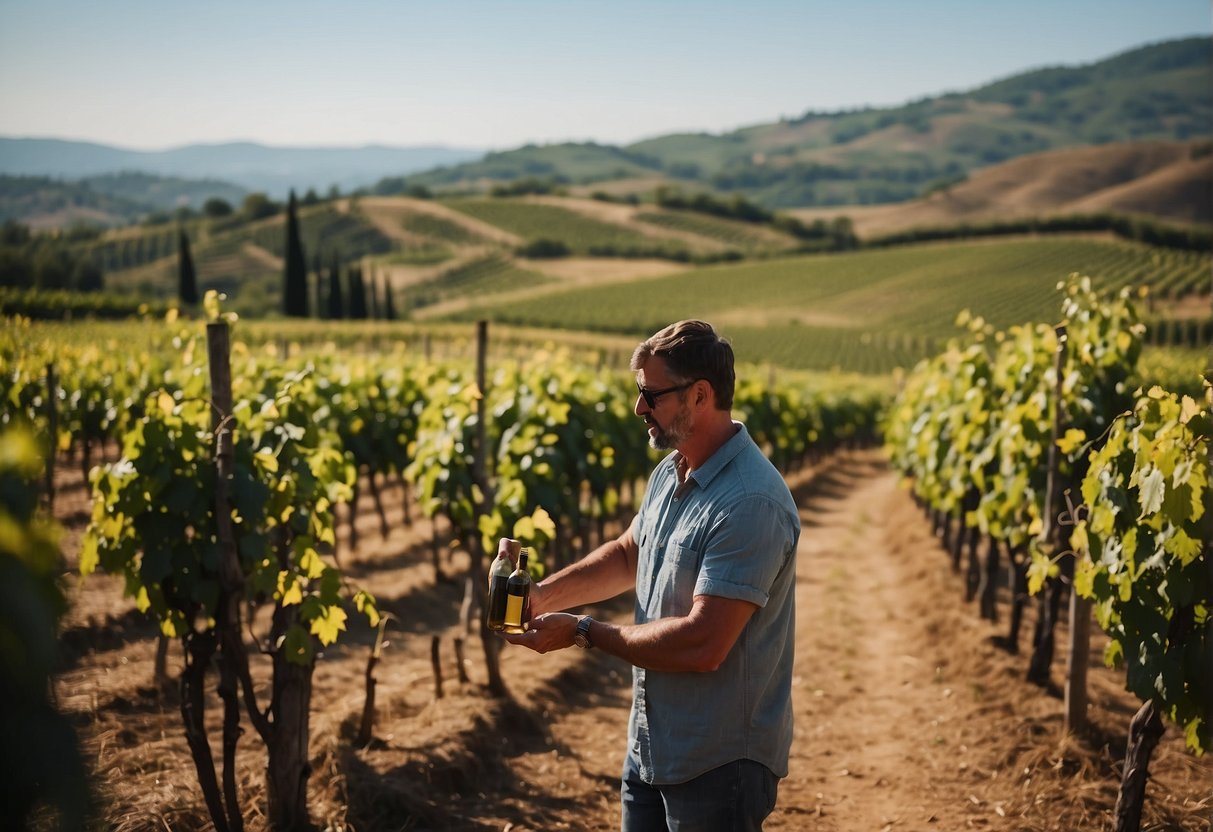
When you embark on the journey of purchasing and collecting Italian wine, especially from the prestigious Tuscany wine region, there are some key factors to consider.
Firstly, understand the typical varietals of Tuscany like the renowned Sangiovese used in Chianti and Brunello di Montalcino wines. Recognizing these varietals will guide you in selecting wines that have the potential to age well and increase in value.
If you’re interested in wine tours in Tuscany, consider experiences that might allow you to visit vineyards and purchase directly.
You’ll have the chance to Book Wine Tours in Tuscany that include tastings and opportunities for purchase.
When storing your wines, remember that proper conditions are crucial.
Your Tuscan wines should be kept at a consistent temperature and humidity levels. Wine fridges or cellars are ideal for this purpose.
- Quick Checklist for Starting Your Collection
- Identify reputable vendors: Choose shops with expertise in Tuscany wines.
- Document your purchases: Keep track of what you buy, the price, and potential maturity dates.
- Consider rarity: Limited edition bottles or vintages from exceptional years often hold or increase in value.
- Connect with a community: Joining wine clubs or forums can provide valuable insights and further your education on collecting.
Italian wines from Tuscany are esteemed for their bold flavors and ageing potential, making them excellent candidates for your collection. Happy hunting!
Frequently Asked Questions
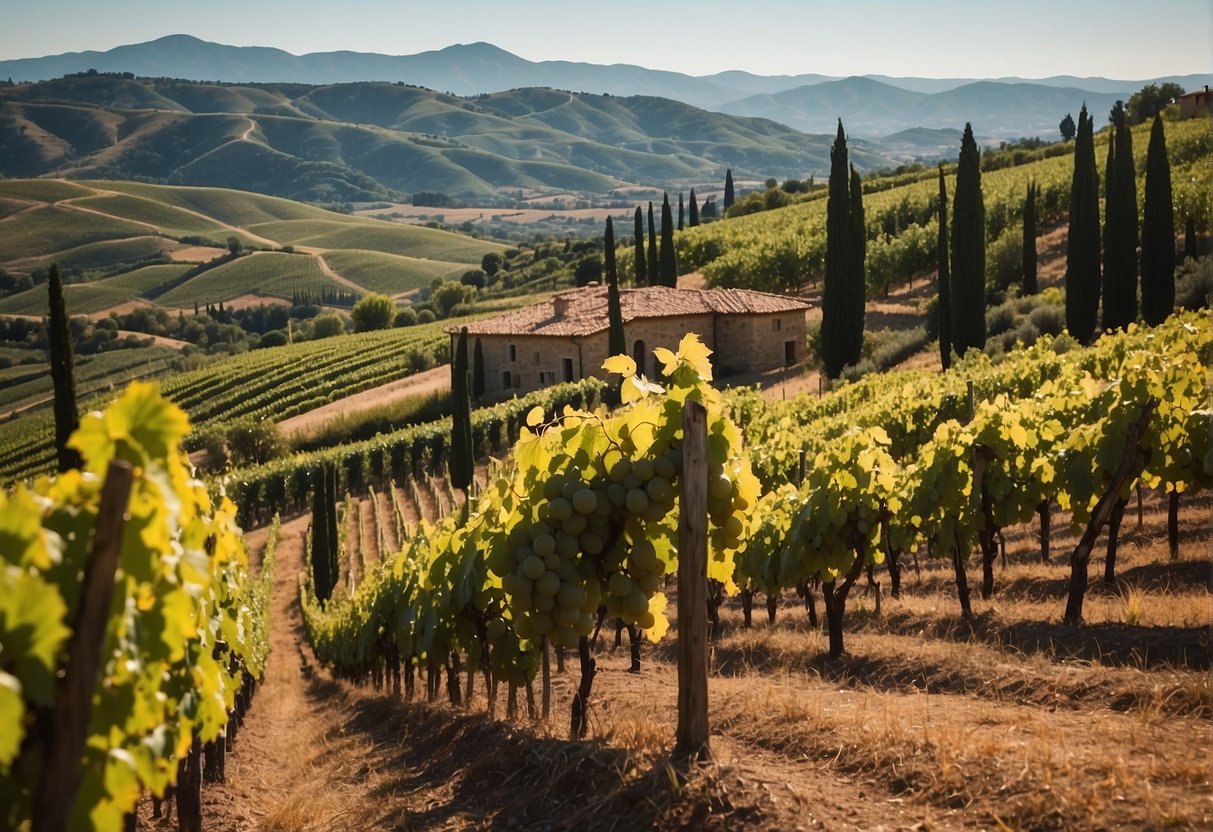
Tuscany’s rich wine culture offers a tapestry of flavors that are as varied as the region’s landscape. Whether you’re a seasoned oenophile or a curious traveler, these FAQs will guide you through the essential elements of the Tuscan wine experience.
What are the top varietals one can expect to discover in the Tuscan wine landscape?
In Tuscany, your palate is treated to renowned red varietals such as Sangiovese, the bedrock of Chianti and Brunello di Montalcino wines. Cabernet Sauvignon and Merlot have also found a home here, contributing to the famed Super Tuscans.
Which towns are considered must-visit spots for wine enthusiasts touring Tuscany?
You should not miss the charming towns of Montalcino and Montepulciano, famous for their Brunello and Vino Nobile wines, respectively. For a touch of medieval splendor paired with excellent wines, add Siena and San Gimignano to your itinerary.
What are some essential white wines to try when exploring the vineyards of Tuscany?
While Tuscany is dominantly red, make sure to savor the crisp and refreshing Vernaccia di San Gimignano and the aromatic Vermentino, which are among the region’s celebrated white wines.
Can you recommend any iconic wineries to include on a Tuscany wine tasting itinerary?
Absolutely! Visit the historic estates of Antinori for a taste of their innovative Super Tuscan blends or explore the traditional flavors at Frescobaldi. Don’t miss the chance to experience the legendary Ornellaia for a luxurious tasting.
What climatic factors contribute to Tuscany’s reputation as a producer of fine wines?
Tuscany’s climate plays a pivotal role in its wine production. The warm, sunny days are balanced by cool nights, ensuring grapes mature perfectly. This results in a balance between sugar and acidity that is ideal for winemaking.
For someone staying in Florence, what are the best day-trip options to visit nearby wine regions?
From Florence, you can easily venture into the heart of Chianti, just a short drive away.
Explore the scenic wineries nestled in rolling hills. Stop by the town of Greve in Chianti for a quaint yet immersive wine experience.
